
Bronze Age 2000 - 700 BC
Return to Gallery
Display Contents
Roundbarrows on Thanet
Curator's introduction
What is a roundbarrow?
Houses of the dead?
In the beginning
MBA roundbarrows
End of the roundbarrow
The re-use of roundbarrows in the Anglo-Saxon period
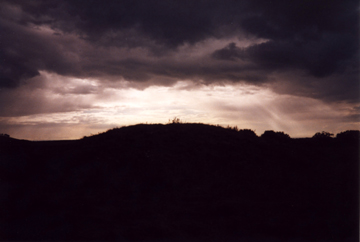
The roundbarrows distributed around the landscape of the
Click here to link to a Display on the archaeology of ring-ditch and roundbarrow monuments of Thanet
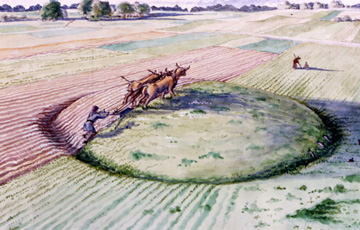
By Len Jay
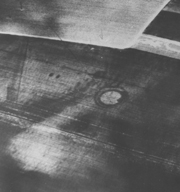
Photographer unknown
It is possible that the slighting of these monuments to the dead may have been actively pursued and encouraged during the Medieval and Post- Medieval periods.
Some people may have believed that these ancient monuments represented an unacceptable Pagan presence in their landscape. The great Henge-Enclosure monument at Avebury shows evidence of being slighted during these periods, when many of the standing stones were buried or destroyed.
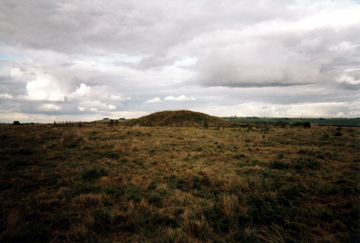
Causeway: an interruption in the circle of a ring-ditch which provides access into the monument.
Ring-ditch: a monument without an internal burial.
The vast majority (if not all) of the ring-ditch monuments are likely to represent barrows of some form.
Roundbarrow: a ring-ditch monument with an internal burial.
On Thanet the ditch has often cut into the underlying deposits of the Upper Chalk and one can envisage these mounds originally having been made with, or capped by, gleaming white chalk. This would have made them highly visible, prominent features in the landscape.
Sometimes there are additional grave pits dug around the main burial and later burials may also be inserted into (or through) the mound or cluster just outside the barrow in a 'flat-grave cemetery'.
Roundbarrows come in a great variety of sizes and types. Click here to see a brief explanation of some different roundbarrow types.
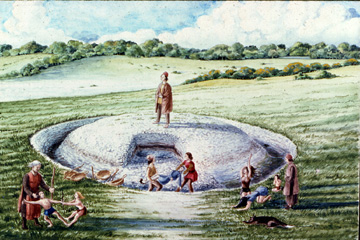
By Len Jay
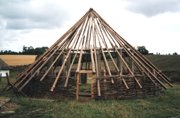
Roundhouses
at Butser Ancient Farm
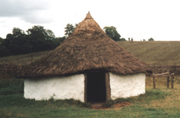
The
traditional burial monuments of the Neolithic and the Bronze Age echo
the form of the houses in which our ancestors lived.
If you get a chance to visit a reconstruction of one of these houses (there are several around the country, perhaps most famously at Butser Ancient Farm - Butser.org.uk) please venture in - its a magical experience, a real time machine!
From around the beginning of the Beaker Period roundbarrows were adopted as the preferred burial monument throughout the country.
In the
Early Bronze Age the central earthen mound often became the focus for
secondary
cremation burials. These were contained in large pottery vessels called
Collared and Cordoned Urns.
On Thanet only a couple of roundbarrows are known to have survived with any significant remnant of their mounds intact.
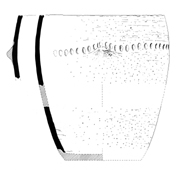
A Deverel Rimbury cremation urn from Bon Secours, Ramsgate
Illustrated by Maggy Redmond
Middle
Bronze Age roundbarrows
After
the beginning of the Middle Bronze Age (circa 1500 BC) the tradition of
inhumation and the construction of roundbarrows
started to decline and
cremation became the dominant burial custom.
Cremations were usually (but not always) contained in large pottery vessels called Barrel and Bucket Urns and may be found buried (frequently inverted) in pits cut into the ground. Elsewhere in Britain large numbers of these burials can form ‘Urnfields’, but no such large scale burial groups have yet been found on Thanet.
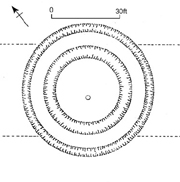
A Middle Bronze Age double-ditched roundbarrow
from King Edward Avenue, Broadstairs
The central pit contained an inverted, atypical pottery vessel
By Howard Hurd (1909)
Roundbarrows were still being constructed during
this period however. A small ring ditch (4m in diameter) was uncovered
by the Trust for Thanet Archaeology at
Bon Secours, Ramsgate.
This was surrounded by several pits containing Deverel
Rimbury
cremation urns.
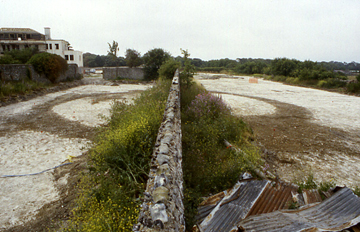
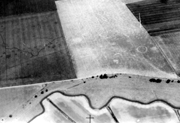
Aerial photograph of the cropmarks at Great Brooksend Farm showing a varied selection of interesting cropmarks, some of which are now Scheduled Ancient Monuments
Photographer unknown
The construction of roundbarrows was becoming increasingly rare as the Middle Bronze Age progressed. It is thought that those that were built were generally of characteristically small size (less than 10m in diameter).
Roundbarrows largely ceased
being built around 1000 BC, but a few have been dated
occurring as late as 700 BC.
in the Anglo-Saxon period
Saxon burials are often found associated with the much earlier Bronze Age roundbarrows; though as Ges Moody has pointed out it may have been difficult for any large cemetery not to have encountered a roundbarrow on Thanet!
It may demonstrate a Saxon acknowledgment of ancient, sacred burial grounds and their desire to bury their dead on already 'hallowed' ground. Could it also have been an attempt by Saxon migrants to adopt their new home's indigenous ancestors (and their land) as their own?
One vital and fascinating question is how many of the people who were buried in the Saxon cemeteries were actually Continental migrants anyway, rather than the local Britons adopting the trappings and aspects of a new, exciting Continental Saxon culture? An interesting subject for future research!
Click here to link to a Display on the archaeology of the ring-ditch and roundbarrow monuments of Thanet.
Bibliography
Bennet P. et al 1996. Interim report
on excavations in advance of the dualling
of the A253 between Monkton and
Version 1 - Posted 10.08.06
Version 2 - Posted 21.10.06